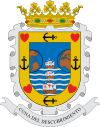Palos de la Frontera
| Palos de la Frontera municipality | ||
|---|---|---|
| coat of arms | Map of Spain | |

|
|
|
| Basic data | ||
| Autonomous Community : | Andalusia | |
| Province : | Huelva | |
| Comarca : | Huelva | |
| Coordinates | 37 ° 13 ′ N , 6 ° 53 ′ W | |
| Height : | 23 msnm | |
| Area : | 50 km² | |
| Residents : | 11,289 (Jan 1, 2019) | |
| Population density : | 225.78 inhabitants / km² | |
| Founding: | 1379 | |
| Postal code : | 21810 | |
| Municipality number ( INE ): | 21055 | |
| administration | ||
| Mayor : | Carmelo Romero Hernández ( PP ) | |
| Website : | www.palosfrontera.com | |
| Location of the municipality | ||

|
||
Palos de la Frontera is a city in the province of Huelva in the autonomous region of Andalusia in Spain . Its distance to the provincial capital Huelva is 14 km. It is located on the left bank of the Río Tinto , near the mouth of the Río Odiel , where it joins the Río Tinto.
Palos de la Frontera describes itself as the "cradle of the discovery of America". From here Columbus set sail with the two caravels Niña and Pinta and the carrack Santa Maria on August 3, 1492 when he wanted to discover the sea route to India. Outstanding personalities of the city - such as B. the Pinzón brothers - played a central role in the discovery of America by the Europeans.
history
The name of the city goes back to the Latin word palus , which in this context means something like "swamp" or "lake". Until 1642 the city was only called Palos. In the middle of the 16th century, the first chroniclers of the discovery of America , Gonzalo Fernández de Oviedo and Francisco López de Gómara , mistakenly believed that Palos and Moguer were one and the same place. They therefore created the name Palos de Moguer , which quickly found its way into the encyclopedias and textbooks of the time.
In May 1642, the Palos City Council decided to rename the city Palos de la Frontera . He made use of the fact that the rebellious Marqués de Ayamonte had led Portuguese troops across the border river Guadiana to the east to the Río Tinto . With the new addition to the name, the false impression that Palos had appeared as the village of the neighboring town of Moguer could be suppressed.
Population development
| year | 1900 | 1910 | 1920 | 1930 | 1940 | 1950 | 1960 | 1970 | 1981 | 1991 | 2000 | 2008 |
|---|---|---|---|---|---|---|---|---|---|---|---|---|
| Residents | 1621 | 1902 | 1922 | 2201 | 2280 | 2469 | 2540 | 4390 | 5901 | 6750 | 7115 | 8964 |
| Source: Instituto Nacional de Estadística (INE) | ||||||||||||
economy
In recent years economic activity has shifted away from traditional fishing and towards modern industrial production. Another important industry is agriculture. Particularly noteworthy here is the large-scale cultivation of strawberries that is typical of the Huelva province.
Attractions
- Iglesia de San Jorge in Mudejar style . Next to the church are the remains of the Palos castle.
- Museo de Martín Alonso Pinzón. Here the visitor can view nautical instruments, paintings and maps related to the discovery of America. A monument commemorates the captain Columbus and important citizen Martín Alonso Pinzón .
- La Rábida Franciscan Monastery (on the road to Huelva).
- The botanical garden (also on the road to Huelva), created by José Celestino Mutis , with native and American species.
- Muelle de las Carabelas ("Wharf of the Caravels"). Here are the replicas of the two caravels Pinta and Niña and the carrack Santa Maria , with which Columbus set off for India in search of the sea route (the replicas were specially made and displayed for the celebration of the 500th anniversary of the discovery of America in 1992 the Expo in Seville ).
- Muelle de la Reina ("Queen's Pier"). A monument to Icarus commemorates the first intercontinental flight of the seaplane Plus Ultra from Huelva to Buenos Aires in 1926, which attracted worldwide attention .
Pope visit
On June 14, 1993 Pope John Paul II visited Palos de la Frontera. I.a. He paid tribute to the city's outstanding historical significance, both for the character of the modern world and for the spread of Christianity.
Town twinning
The city maintains partnerships with the cities, among other things
|
as well as with |
sons and daughters of the town

- Martín Alonso Pinzón (1441–1493), Spanish navigator and participant on the first Columbus voyage
- Vicente Yáñez Pinzón (~ 1460–1523?), Spanish navigator and explorer, participant on the first Columbus voyage
- Francisco Martín Pinzón (~ 1445–1502?), Spanish navigator and explorer
- Juan Rodriguez Mafrá
- Gonzalo Guerrero (before 1500 - probably 1536), Spanish sailor, lived with the Maya after the shipwreck
- Antón de Alaminos (1482–1520?), Spanish helmsman and explorer
Individual evidence
- ↑ Cifras oficiales de población resultantes de la revisión del Padrón municipal a 1 de enero . Population statistics from the Instituto Nacional de Estadística (population update).
Web links
- Palos de la Frontera - statistical information from the Government of Andalusia (Spanish)
- Website of Palos de la Frontera (Spanish, partly also English)




